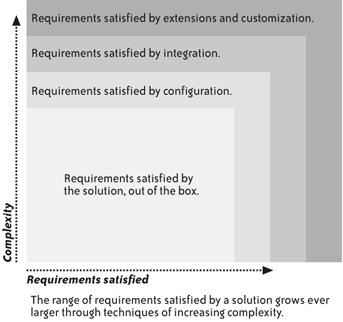Section 4.22. How does ESA provide for easier adaptation and a better requirements fit?
4.22. How does ESA provide for easier adaptation and a better requirements fit?Historically, filling in the gaps between a company's IT needs and the out-of-the-box functionality of any given enterprise application required any number of steps. Configuration of the application using metadata might address some needs, and tighter integration with preexisting applications and their processes would address others. If those were not enough, IT was expected to create extensionsnew components welded onto the applicationor even customized code written by the company's developers. As depicted in Figure 4-9, these efforts gradually narrowed the gaps between the customer's requirements for the application and its actual functionality, but at a growing cost of complexity, and its corresponding costs of developer time and resources. Figure 4-9. How requirements are satisfied Enterprise services fill more of these gaps by creating the reusable building blocks that companies can combine easily to meet new requirements. As mentioned earlier in this chapter, the phrase loosely coupled describes enterprise services' characteristic of interacting in well-defined ways without needing to know each other's inner workings. This means that the service's functionality can change without affecting the services that use it, as long as the behavior described in its interface remains the samethat is, as long as it continues providing the functionality it promised. The opposite of loosely coupled is tightly coupled, which means that the internal workings of a system are exposed and that to work with it, you must understand the minute details of its inner workings, resulting in a very high level of complexity. Changing a single piece leads to unpredictable results, which leads to businesses becoming more afraid of potential side effects than excited about improving processes. But that isn't a problem for enterprise services, which represent much smaller portions of functionalitysmall enough so that opening the hood and tinkering is a more productive and less intimidating endeavor with a greatly reduced risk of disrupting existing processes. The net result is that it's much easier to adapt an enterprise services environment to meet a much larger set of requirements than it is to adapt a conventional application. When you add the new tools that make development easier and that widen the potential pool of developers, it's easy to see how a much larger set of processes can be automated as needed. |
EAN: 2147483647
Pages: 265
- Context Management of ERP Processes in Virtual Communities
- Data Mining for Business Process Reengineering
- Intrinsic and Contextual Data Quality: The Effect of Media and Personal Involvement
- A Hybrid Clustering Technique to Improve Patient Data Quality
- Development of Interactive Web Sites to Enhance Police/Community Relations
- Chapter IV How Consumers Think About Interactive Aspects of Web Advertising
- Chapter VI Web Site Quality and Usability in E-Commerce
- Chapter VIII Personalization Systems and Their Deployment as Web Site Interface Design Decisions
- Chapter XV Customer Trust in Online Commerce
- Chapter XVI Turning Web Surfers into Loyal Customers: Cognitive Lock-In Through Interface Design and Web Site Usability